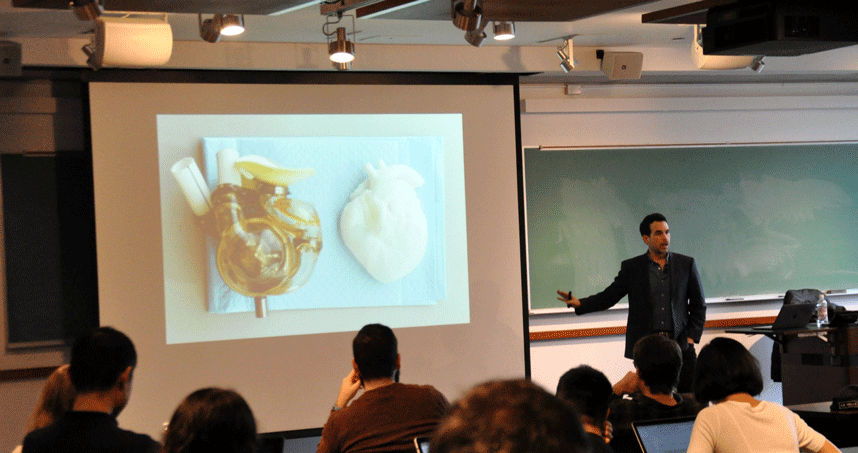Dario Robleto Discusses “The Art of Scientific Storytelling” with PhD Students
Robleto gave the second 2018-19 PhD Students Seminar Series lecture to a full house at Ford’s ITW Classroom
During the second lecture of the 2018-19 Whole-Brain Leadership for PhD Students Seminar Series, transdisciplinary artist Dario Robleto challenged Northwestern Engineering PhD students to consider ways scientific investigations can be enhanced by art’s sensitivity to the human experience.
“How can a scientist become the Emily Dickinson of data or the Patsy Cline of experiment design?” he posed to the crowd at the Ford Motor Company Engineering Design Center’s ITW Classroom on November 12.
In spring 2018, Robleto worked in collaboration with Northwestern Engineering and the Block Museum of Art as part of the new Artist-at-Large Program through the Engineering + Art initiative. Robleto’s art has appeared in museums and galleries across the United States, and universities throughout the country have also hosted him as a visiting artist and scholar.
In Robleto’s talk, “The Art of Scientific Storytelling,” he discussed the deep connections between art and science through his own creative research methods, narrative storytelling, and exploration of sound and sculpture.
“Part of my job as an artist is to observe other fields and to make this case that sometimes an idea is just so big that it transcends its field of origin,” he said. “Siloed thinking needs to be challenged, especially with the problems ahead of us currently, but also in the years to come.”
For example, scientists and artists can collaborate to innovate new heart transplant devices, Robleto said. In 2011, a Texas man, Craig Lewis, received the first “beatless” heart, an artificial heart composed of rotating blades that does not produce a pulse or heartbeat. Dr. Doris Taylor created the concept of a “ghost heart,” which involves stripping an extracted heart of its cells and injecting it with a person’s stem cells to ensure their body will not reject the implanted heart.
“Investigating a ‘beatless’ heart led me to uncovering the sound of a fetal heartbeat from (a 1908 recording),” said Robleto, which inspired his art installation, ‘The First Time, The Heart.’ “I don’t know that I would have ever arrived there without that initial interest in the engineering of the ‘beatless’ heart.”
Robleto’s interest in studying the heart inspired the installation where he showcased 50 prints depicting the first recordings of a person’s pulse during different experiences such as smelling lavender, drinking a glass of hot milk, or being tickled by a feather, recorded between 1854-1913.
“Dario’s work is born out of cross-disciplinary research and collaboration, works across sculpture, installation, and sound to explore the intersections of music, popular culture, language, storytelling, and the histories of science and war,” said Malcolm MacIver, professor of biomedical engineering and mechanical engineering, who introduced Robleto’s presentation. “He’s a person unbounded curiosity and creativity."
“On paper, we can give lip service to the idea of cross-disciplinary thinking, but that’s just not enough for me,” Robleto said. “The heart of the problem is ‘what happens when you collaborate in such a way that both fields change in the process?’”
